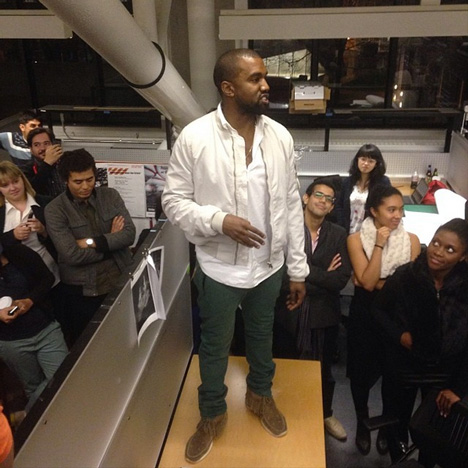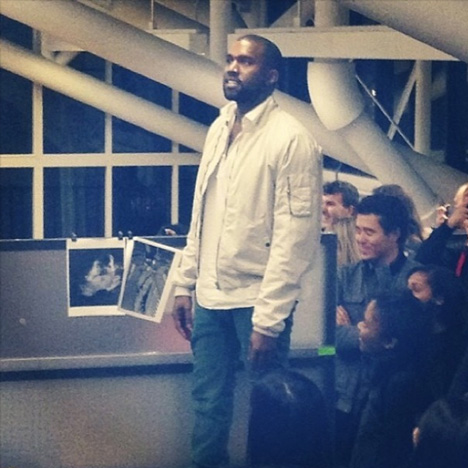
Mockery of Kanye West's design ambition is "racist" says African-American activist
News: the scornful response to Kanye West's recent pronouncements on architecture is part of the "long history of making fun of black people" in America, according to an African-American design student organisation.
"There's a long history in the United States of making fun of black people that actually make it," said Héctor Tarrido-Picart, co-president of the African American Student Union (AASU) at Harvard Graduate School of Design.
He told Dezeen: "We read it as him being mocked for being an ambitious black man."
Tarrido-Picart made the comments after his organisation spent two hours discussing the lack of black representation in architecture with rap star West, who visited Harvard Graduate School of Design last week and gave an impromptu speech to students. "I really do believe that the world can be saved through design," said West in the address.
The speech was the latest in a series of pronouncements on architecture and design by West, who has long been interested in the subjects but has recently started to engage with leading creatives, commissioning graphic artist Peter Saville to design a logo for him and hiring architects Office for Metropolitan Architecture to design a temporary cinema.
West also spoke of his passion for design in a recent interview with The New York Times in June and during an interview with BBC Radio 1 in September, in which he spoke of "going to the Louvre, going to furniture exhibits and understanding that, trying to open up and do interviews with this, learning more about architecture".
However West also expressed frustration at the opposition he has faced: "Taking one thousand meetings, attempting to get backing to do clothing and different things like that. Like, getting no headway whatsoever."
Tarrido-Picart believes the ridicule and resistance is due to the "remnants of the racist society that we have grown up in," which prevent African-Americans crossing over into "higher realms of culture" such as art, design and architecture.
He pointed to figures from the American Institute of Architects showing that only one percent of registered US architects are African-American, despite making up over 12 percent of the total population.
"Why [does] racism still exist in an era where Obama is president and cultural figures like Jay Z and Kanye West create culture," asked Tarrido-Picart. "But when it comes to trying to expand their creativity to other fields, [they] run into walls that could not be better described than remnants of the racist society that we have grown up in?"
West visited Harvard Graduate School of Design while in Boston for a concert, following an invitation from the AASU, who invited the star to meet them following West's BBC Radio 1 interview.
"I have reached the glass ceiling - as a creative person, as a celebrity," West said in the interview, adding: "When I say that it means I want to do product. I am a product person. Not just clothing but water bottle design, architecture, everything that you could think about. And I've been at it for 10 years, and I look around and I say, 'Hey wait a second - there's no one around here in this space that looks like me'."

Tarrido-Picart said: "We were struck first by the depth of knowledge that Kanye West actually had on architecture and second, because of the real question that he raised, which is [that] when you're a very clearly a very talented and creative person and you choose to expand that creativity to new fields, you run into a wall. And that wall isn't a wall that's revolving around your creativity but a wall that's revolving around the colour of your skin."
He added: "That resonated a lot with us and we decided to send out a personal letter to Kanye West in which we expressed the same concerns and reverberated and resonated with what he was saying in that interview."
"He agreed with us in terms of us in identifying with the fact that he was a very creative person and wanted to start creativity in the realm of design and architecture, and he thought that the fact that the colour of our skin plays a very limiting factor," said Tarrido-Picart. "It's not just about under-representation but also an active question that racism is very much alive in the United States."
"He questioned us about what culture is and trying to surpass that by going into higher realms of culture, so art, design, architecture," he continued. "He sees that as the natural next step."
The AASU has signed a non-disclosure agreement with West so cannot reveal the precise nature of their discussions with the star, but it is understood that they agreed to work together to raise awareness of, and tackle, the under-representation of minorities in American architecture.
"We're going to try and maintain an active discussion with Kanye," Tarrido-Picart said. "He expressed a deep interest in this being something that is not just short term, but actually long term in terms of actually shaping the future of landscape of what design and culture is going to be, not only in the United States but around the world."
He added: "What we hope to do is to raise the question that Kanye has [raised in a] very serious manner in our industry."
Below is a statement issued by the AASU following its meeting with West:
Why the African American Student Union met with Kanye West at the Harvard University Graduate School of Design
This past summer, members of the Harvard University Graduate School of Design’s African American Student Union (AASU) were stirred by a series of interviews with Kanye West referencing his growing interest in design.
Mr. West’s very public frustration with the limits experienced by Black designers and artists energized and excited the group, prompting a series of internal conversations. Framing these discussions was the fact that only 1% of licensed architects in the United States identifies as being African-American. We discussed how this severe under-representation of African Americans in producing the built environment which have a range of effects upon our collective lives.
Subsequent to these discussions, the AASU decided to reach out to Mr. West.
We were tremendously excited that Mr. West, well-aware of these challenges, desired to meet us as well. This Sunday, he met with the AASU privately to discuss how we might pursue meaningful change together. Mr. West is an artist at the center of this generation’s cultural production and shares in our group’s optimism that transdisciplinary design practice can - as he stated Sunday - impact the world in positive ways. One of these ways is by encouraging the development and legitimacy of African American designers in their professional and academic practices. We are fortunate that the GSD has provided us with a platform in which this dialogue can occur.
We look forward to continuing this conversation with Mr. West, and through these efforts, we aim to catalyse a more inclusive design culture.
Sincerely,
The Harvard University Graduate School of Design - African American Student Union